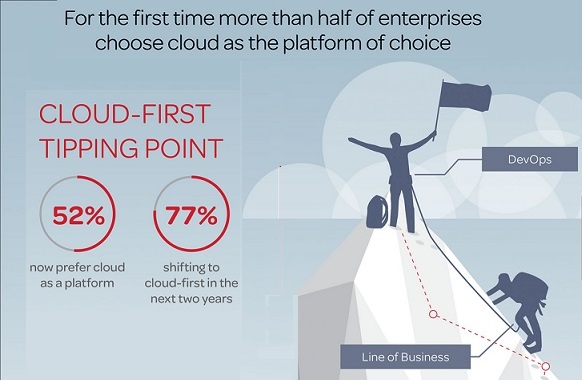Here in the software world, we are beyond the beginning of technology advancements and we continue to accelerate faster than organizations are able to adapt toward further innovation. A simple truth, though: Organizations must find a way to future proof themselves or face some tough realities ...
DevOps
Everybody loves DevOps. In fact, DevOps is the hottest date in IT. That's because DevOps promises to satisfy the deepest longings of digital business — including fast execution on innovative ideas, competitively differentiated customer experiences, and significantly improved operational efficiencies ...
While DevOps and continuous delivery models can (in theory) accelerate technology projects and help them run more smoothly and predictably, the required cultural realignment can prevent companies from reaping the full benefits. Developing and executing an effective strategy means shifting how teams collaborate and interoperate — and we all know how everyone loves change. Here are four steps that enterprise IT leaders are undertaking to facilitate the cultural adaptation and collaboration required to maintain IT and business agility ...
DevOps is moving into the mainstream, according to a new survey conducted by Redgate Software. Nearly half (47 percent) of companies surveyed have already adopted DevOps across some or all of their IT projects ...
Until recently, many IT leaders still believed they could allow their mainframe environments to languish in two-code-drops-a-year waterfall mode, while they embraced DevOps and Agile across their distributed and cloud environments. This so-called "Bimodal lT" strategy has proven to be dangerously flawed. So how do you actually get your mainframe environment up to speed? ...
Blueprint predicts that application development will become more complex through 2017 as new processes and technologies change the way organizations develop products and engage with markets. As the volume and complexity of development projects grow, enterprises will continue to shift toward Agile and continuous delivery, and new technologies that enable collaboration between stakeholders will be essential. Here are Blueprint's top four predictions for enterprise software development in 2017 ...
What I think we will see in 2017, is an acceleration of the adoption of DevOps, especially within enterprises as the largest enterprise software companies continue developing their DevOps tool set ...
If there's any consistent criticism that's been leveled at the DevOps movement, it's that the term comprises such a wide range of concepts to so many different people, and that it's become more closely associated with marketing than real-world adoption. So how do you overcome such critiques? Obviously the onus is upon those of us working in the space — especially on the provider side — to put a finer point on what DevOps (currently) encompasses in a practical sense. A big part of this must be found in highlighting those real-world use cases where DevOps is having the most significant impact ...
The following are 2017 predictions for DevOps from the executive team at XebiaLabs, covering Analytics, Monitoring, Big Data, Serverless, Container Orchestration and more ...
The following are 2017 predictions for DevOps from the executive team at Electric Cloud, covering Application Release Automation, Microservices and Containers, Continuous Testing, Secure DevOps and more ...
A lot of time, resources and energy has been invested over the past few years on de-siloing development and operations. And with good reason. DevOps is enabling organizations to more aggressively increase their digital agility, while at the same time reducing digital costs and risks. But as 2017 approaches, the hottest trends in DevOps aren’t specifically about dev or ops. They’re about testing, security, and metrics ...
DevOps experts — analysts and consultants, users and the top vendors — offer thoughtful, insightful, often controversial and sometimes contradictory predictions on how DevOps and related technologies will evolve and impact business in 2017. Part 6, the final installment, covers DevOps tools and DevOps people ...
DevOps experts — analysts and consultants, users and the top vendors — offer thoughtful, insightful, often controversial and sometimes contradictory predictions on how DevOps and related technologies will evolve and impact business in 2017. Part 5 covers the many facets of DevOps including analytics, security, collaboration and more ...
DevOps experts — analysts and consultants, users and the top vendors — offer thoughtful, insightful, often controversial and sometimes contradictory predictions on how DevOps and related technologies will evolve and impact business in 2017. Part 3 is all about the cloud ...
DevOps experts — analysts and consultants, users and the top vendors — offer thoughtful, insightful, often controversial and sometimes contradictory predictions on how DevOps and related technologies will evolve and impact business in 2017. Part 2 covers development and testing ...
DEVOPSdigest is establishing a tradition with the second annual list of DevOps Predictions. DevOps experts — analysts and consultants, users and the top vendors — offer thoughtful, insightful, often controversial and sometimes contradictory predictions on how DevOps and related technologies will evolve and impact business in 2017. Part 1, the first installment, takes a look at the big picture for DevOps in 2017 ...
DevOps still challenges IT organizations particularly when applied to complex, heterogeneous legacy IT. Those systems must be monitored, secured, scaled, load balanced, and configured, a task that can quickly unravel the promise of DevOps. That's because we tend to carry over many of the pre-DevOps manual and time-consuming infrastructure management tasks into the new world order ...
When looking at the tools and methodologies used today to manage software development, we see a diverse array. There are traditional waterfall methodologies and tools, agile principles, ALM tools, and increasingly, a DevOps toolchain. The primary objective behind each of these approaches and tools is to manage the development and delivery of software for the enterprise. Software development affects all aspects of operations and is tied more closely to the enterprise than ever before. To truly optimize the development lifecycle and enhance collaboration across the enterprise, we must head toward a new generation of tools aimed at accelerating the pipeline while improving quality ...
In many ways running the gauntlet of audit is like playing out the "do I feel lucky" scene from the movie Dirty Harry. Even if organizations have bridged the chasm between Dev and Ops, their go-fast efforts can be shot to pieces by those darned list-wielding and trigger-happy compliance police. But it doesn't have to be this way. Audit needn't kill innovation, just as DevOps shouldn't cause undue consternation for auditors. Each can and should benefit the other; it just takes some work and plain old common sense ...
As the integration of Development and Operations gains traction among business think tanks to ensure development of quality software products and faster delivery schedules, Quality Assurance (QA) takes center stage. In DevOps QA, developers and testers use agile and lean methodologies to test software for glitches during various stages of its development. As a real test environment with a number of dependencies is difficult to be created owing to cost and other factors, service virtualization strategy helps to set up a virtual test environment to check for desired outcomes of the software or the lack of them ...
The success of DevOps depends on both the cultural shift around people and process as well as the technical implementation skills of the team across Dev and Ops. In the final post of this 3-part series, I will focus on the top 5 technology implementation mistakes ...
As organizations continue to adopt a more collaborative DevOps model, many face a common challenge: effectively integrating security practices into the application development lifecycle process. According to a new HPE report, virtually all IT operations professionals, security leaders and developers (99 percent) agree that adopting a DevOps culture has the opportunity to improve application security. However, only 20 percent are actually conducting application security testing today during the development process ...
DevOps implementations can be hindered by lack of involvement from both the business and technology leadership as the team initiates and creates the new DevOps culture. In Part 2 of the 3-part series on Challenges and Solutions for implementing DevOps, I will focus on technology leadership challenges and suggested solutions ...
DevOps is a powerful process that can catapult industry leaders into the next stratosphere of transformation success when combined with the right people, process, and technology. The converse is also true. Applying DevOps principles of agility, continuous integration and delivery without addressing broken processes, gaps in skillsets or technology – is a recipe for disaster. This 3 part blog series will focus on the people and process challenges that impact DevOps implementations across 3 areas – Business, Technology Leadership, and Technology Execution based on my research for my latest book, iSpeak Cloud: Embracing Digital Transformation. This first blog will focus on the Business & Technology interaction ....














